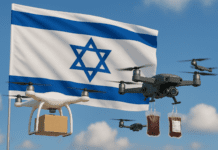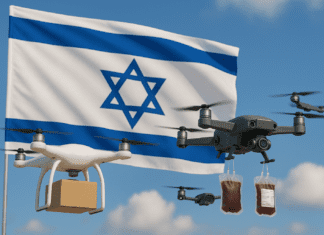This post is also available in:
 עברית (Hebrew)
עברית (Hebrew)
It has already become common knowledge that it doesn’t take much effort to convert an ordinary commercial drone into an airborne threat. To military forces this threat is all too real. Enemy forces could easily strap explosives onto drones and have the drones “kamikaze” into vulnerable areas, not to mention the possibility of using drones as surveillance tools. For this issue, Raytheon has adopted a slightly different approach to combating drones.
The company has been working on developing a drone killing dune buggy. The dune buggy is capable of shooting quadcopters out of the sky for up to four hours on a single charge, allowing it to take up to 30 shots per charge.
The system utilizes a targeting system, which uses optical and infrared sensors to acquire and lock onto airborne targets. Once the system locks onto the target, a human operator verifies the information taken from the sensors and, if necessary, fires a high energy laser knocking the drone out of the sky. A variation of this system has previously been implemented onto Apache AH-64 attack helicopters.
The system has been modified to track types of drones most likely to be used by terror organization. Class 1 drones, weighing under 20 pounds, and class 2 drones, weighing between 20 and 55 pounds.
The reason the drone killing system is installed onto a dune buggy is so operators would be able to drive the buggy into more tactical areas where the enemy may be operating drones from. As of now, the buggy is incapable of firing while in motion, however Raytheon’s engineers are working on versions that can fire while driving.
The dune buggy the system is installed onto is a Polaris MRZR, which can reach speeds of up to 60 mph when stripped of the laser targeting system. Raytheon hasn’t released the weight of the laser system, so we cannot be sure how much it will slow down the buggy.
There are major benefits of using laser systems to take down drones, in contrast to other kinetic countermeasures such as missiles and firearms. It’s easier to track the target using a laser and you can move the laser beam as it is firing, thus making lasers more accurate and reliable. Lasers are also more cost effective, you don’t want to spend hundreds of thousands of dollars on a missile to take out a drone worth a few hundred dollars.
The entire system is called the HELWS (High Energy Laser Weapon System) MRZR, based off the laser weapon system and the Polaris that the system is installed onto.
Raytheon isn’t the only firm tapping into directed energy weaponry against drones. Wired.com mentions that Boeing has also showed off its drone killing lasers.


























